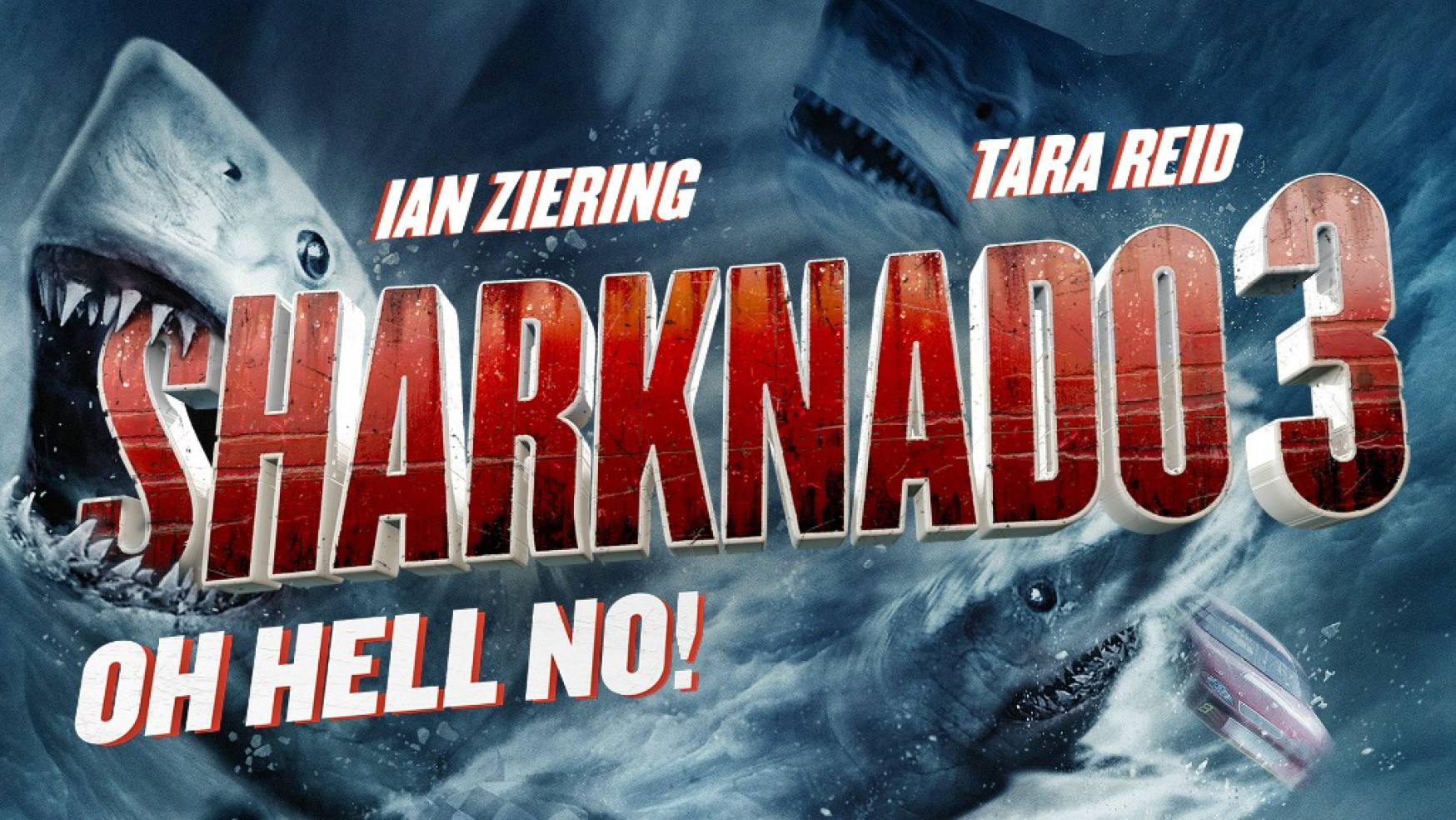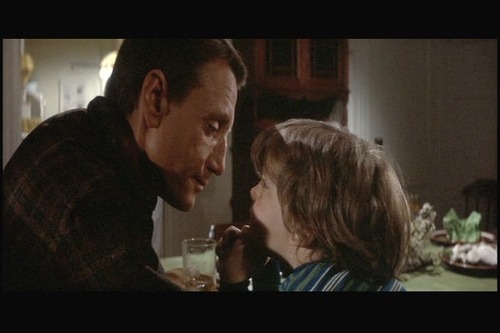
Don’t judge me.
I am a fan of the Sharknado franchise put out by the SyFy Channel. In a nutshell, all three of the movie plots are pretty basic. Literally there are tornadoes erupting in major U.S. cities that are filled with man-eating sharks of all types and sizes. In the first installment it was Los Angeles. The second took place in New York. In Sharknado 3: Oh Hell No!, we start out in the White House and end up at Universal Studios in Orlando, Florida. Flying sharks appear suddenly, eat, kill, and maim people, and then dissipate to form tornadoes again in another part of town. I know, stupid.

The quick and dirty rundown is that Ian Ziering and Tara Reid return as Fin Shepard and April Wexler who are now expecting a new baby together. Fin is accepting the “Order of the Golden Chainsaw” from the President in the White House (Mark Cuban) for saving New York in the last film. While Fin is in D.C., April is in Florida at Universal Studios Orlando with their oldest daughter and Bo Derek (who plays April’s mother, May Wexler). Storms begin eight minutes into the film and it’s the usual farce of flying shark mayhem. Fin tries to get down to Florida to save his family, and he meets up with his former bar employee, Nova Clarke (Cassie Scerbo). Nova tools around in a reinforced RV fighting sharks like a Mad Max movie reject with her nerdy sidekick Lucas (Frankie Muniz). They (minus Lucas) make it to Florida and reunite with Fin’s family. Fin soon finds his way inside a space shuttle with his father Gilbert Shepard (David Hasselhoff) to save the planet from the sharknado infestation.

The only reasons to watch Sharknado 3 (or any of them really) are:
- Cameo Appearances.
There are so many familiar and sometimes controversial faces in Sharnado 3, and part of the fun is chuckling at who actually signed up to appear in it. Most known actors in the SyFy Creature Feature programming are former (minor) stars from the ’80s and ’90s, and some are even names who used to be in blockbuster films a few years ago (Vivica Fox from Independence Day and Kill Bill appeared in Sharknado 2). Sharknado 3 boasts cameos from R&B singer Ne-Yo, Lou Ferrigno (the original Incredible Hulk), Harvey Levin (TMZ host), Jackie Collins (author/socialite), Frankie Muniz (the Malcolm in the Middle star who looked so old in this), and real-life political figures like Anthony Wiener (who now works for a crisis PR firm–oh, the irony), Ann Coulter (why did she not get eaten in this thing?), and Michele Bachmann (so random).
- Landmarks Destroyed
The White House, the Washington Monument, the Capitol Rotunda, and of course, if you saw the other two films set in New York and Los Angeles, you saw the Statue of Liberty lose her head and the Santa Monica Pier’s Ferris Wheel destroy the boardwalk.
- Ridiculous Shark Deaths, Lack of Realism, and Poor CGI
Sharknado 3 is not afraid to show how low-budget it is and how obvious the CGI is crafted. It’s part of the joke in many ways. The producers pour on the cheap-ass quality, and we love it. As our hero Fin gets caught inside his car as a new storm rages around him, he jumps out and has to grab ahold of his car door to keep himself from flying away. Mind you, everything else around him that is heavier than his car is being lifted into the sky, but his vehicle stays put on the ground, barely shaking from the high winds of flying sharks. But we don’t care. Sharks swallow people whole, they slap people to death with their fins, and they bite off all your limbs. Some even gulp you down in outer space. They have no chill. Bonus: George R.R. Martin has a Game of Thrones bloodfest comeuppance.

- Nostalgia for Old School Creature Features
If you grew up loving Lloyd Kaufman’s Toxic Avenger series, Roger Corman’s American International Pictures, or the old Hammer Film Productions, then Sharknado 3 is for you. It’s for people who enjoyed Saturday afternoon Creature Features like Godzilla and Gamera that were often followed by Kung Fu Theater classics.
That’s it.
Sharknado 3 is the Krispy Kreme donut of movies. There is no nutritional value whatsoever for a cinephile, but damn it, as soon as that “Hot Now” sign goes on, you have to have it. It is so god-awful that it’s good. I made Patron flavored cupcakes to snack on as I indulged in the sublime foolishness. Sidenote: Sharknado films are for drinking parties. It’s always better with liquor.
The actors themselves know that this awful TV movie is a fluke to be such a success. Ian Ziering has stated that he took the job only because he needed to work and support his family. The actor Steve Guttenberg reportedly was offered the role of Fin Shepard but turned it down. He regretted it later after the first Sharknado film blew up. (But no worries, he can try to make up for his faux pas by being comical in the upcoming SyFy original movie, Lavalantula. Yes. LAVALANTULA.)

All the Sharknado TV movies owe their popularity and longevity with their mockbuster sequels to us, the fans. We made this cultural zietgiest happen. Social media and livetweets propelled this thing into the fandom stratosphere. The SyFy network have had other audacious TV movies like Frankenfish, Sharktopus, Piranhaconda (stop laughing), Dinoshark, Sharktopus vs. Pteracuda, and a few days ago, Sharktopus vs. Whalewolf (hand to God). But somehow, only Sharknado became a thing. I confess, I own a Sharknado T-shirt, and Sharknado leggings, and wear them proudly like I would my Wonder Woman, Batman, and Loki fan gear. There’s something life-affirming about cherishing pure D-level entertainment. The collective eye-winking warms my heart.

The PR end of Sharknado 1, 2, and 3 was smart to engage the public. As the second movie was being made, there was a contest on Twitter to name the movie subtitle. The best title winner would win actual props from the movie along with having the prestige of naming a campfest. Sharknado 3 is already priming the pump for a new installment. As the premier ended Wednesday night, the SyFy channel posted two Twitter hashtags, #AprilLives and #AprilDies. (Sorry Tara Reid, I tweeted #AprilDies because #teamnova.) The fans will decide the fate of Reid’s character April, who gave birth to Fin’s baby inside of a shark falling to earth from outer space. No, for real. That happened. This type of interaction is gold for fans like me who wonder how the writers/producers will level up from sharks in space. What could they possibly have in store for us hardcore stans in Sharknado 4? The only thing I can add is to have the producers cast me in a walk-on role, where I run from sharks and maybe bash a few upside the noggin with coconuts somewhere in the Fiji Islands. I’m just saying.
Until Sharknado 4 appears, I’ll eagerly await giant spiders spewing lava from their butts. Bring it SyFy channel. I’m a ride or die fan waiting for my close-up.

Staff writer Lisa Bolekaja is the co-host of Hilliard Guess’ Screenwriters Rant Room. When not watching cheesy SyFy flicks, she can be found in the Twitter hashtags #SaturdaynightSciFi and #Fridaynighthorror. She divides her time between Italy and several cities in California. You can read her short SF/F story “Three Voices” at Uncanny Magazine.











